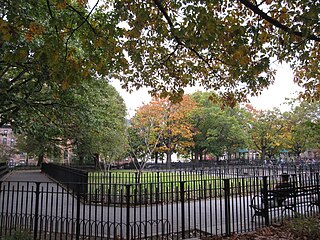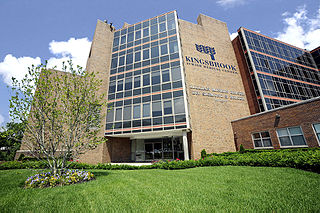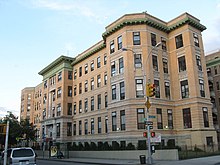
Brooklyn is a borough of New York City located at the westernmost end of Long Island in the State of New York. Formerly an independent city, the borough is coextensive with Kings County, one of twelve original counties established under British rule in 1683 in the then Province of New York. As of the 2020 United States census, the population stood at 2,736,074, making it the most populous of the five boroughs of New York City, and the most populous county in the state. Brooklyn, at 37,339.9 inhabitants per square mile (14,417.0/km2), is the second most densely populated county in the U.S. after Manhattan, as of 2022. Had Brooklyn remained an independent city, it would now be the fourth most populous American city after the rest of New York City, Los Angeles, and Chicago.

Crown Heights is a neighborhood in the central portion of the New York City borough of Brooklyn. Crown Heights is bounded by Washington Avenue to the west, Atlantic Avenue to the north, Ralph Avenue to the east, and Empire Boulevard/East New York Avenue to the south. It is about one mile (1.6 km) wide and two miles (3.2 km) long. Neighborhoods bordering Crown Heights include Prospect Heights to the west, Flatbush and Prospect Lefferts Gardens to the south, Brownsville to the east, and Bedford–Stuyvesant to the north.

Clinton Hill is a neighborhood in north-central Brooklyn, a borough of New York City. It is bordered by the Brooklyn Navy Yard and Flushing Avenue to the north, Williamsburg to the northeast, Classon Avenue and Bedford–Stuyvesant to the east, Atlantic Avenue and Prospect Heights to the south and southwest and Vanderbilt Avenue and Fort Greene to the west.

Cobble Hill is a neighborhood in the northwestern portion of the New York City borough of Brooklyn. A small neighborhood comprising 40 blocks, Cobble Hill sits adjacent to Brooklyn Heights to the north, Boerum Hill to the east, Carroll Gardens to the south, and the Columbia Street Waterfront District to the west. It is bounded by Atlantic Avenue (north), Court Street (east), Degraw Street (south) and the Brooklyn Queens Expressway (west). Other sources add to the neighborhood a rectangle bounded by Wyckoff Street on the north, Hoyt Street on the east, Degraw Street on the south, and Court Street on the west.

Fulton Street is a long east–west street in northern Brooklyn, New York City. This street begins at the intersection of Adams Street and Joralemon Street in Brooklyn Heights, and runs eastward to East New York and Cypress Hills. At the border with Queens, Fulton Street becomes 91st Avenue, which ends at 84th Street in Woodhaven.

Bedford–Stuyvesant, colloquially known as Bed–Stuy, is a neighborhood in the northern section of the New York City borough of Brooklyn. Bedford–Stuyvesant is bordered by Flushing Avenue to the north, Classon Avenue to the west, Broadway to the east, and Atlantic Avenue to the south. The main shopping street, Fulton Street, runs east–west the length of the neighborhood and intersects high-traffic north–south streets including Bedford Avenue, Nostrand Avenue, and Stuyvesant Avenue. Bedford–Stuyvesant contains four smaller neighborhoods: Bedford, Stuyvesant Heights, Ocean Hill, and Weeksville. Part of Clinton Hill was once considered part of Bedford–Stuyvesant.

SUNY Downstate Health Sciences University is a public medical school and hospital in Brooklyn, New York. It is the southernmost member of the State University of New York (SUNY) system and the only academic medical center for health education, research, and patient care serving Brooklyn's 2.5 million residents. It is the only state-run hospital in New York City. As of Fall 2018, it had a total student body of 1,846 and approximately 8,000 faculty and staff.

The Brooklyn Hospital Center is a 464-licensed-bed, full-service community teaching hospital located in Downtown Brooklyn, New York City. The hospital was founded in 1845. It is affiliated with the Mount Sinai Health System, and serves a diverse population from a wide range of ethnic backgrounds.

The Union Temple of Brooklyn was a Reform Jewish synagogue located at 17 Eastern Parkway between Underhill Avenue and Plaza Street East in the Prospect Heights neighborhood of Brooklyn, New York City, across the street from the Brooklyn Public Library, the Brooklyn Museum, and the Brooklyn Botanic Garden. On March 26, 2021 Union Temple merged with Congregation Beth Elohim.

Queens Hospital Center (QHC), also known as NYC Health + Hospitals/Queens and originally called Queens General Hospital, is a large public hospital campus in the Jamaica Hills and Hillcrest neighborhoods of Queens in New York City. It is operated by NYC Health + Hospitals, a public benefit corporation of the city.

Mount Sinai Beth Israel is a 799-bed teaching hospital in Manhattan. It is part of the Mount Sinai Health System, a nonprofit health system formed in September 2013 by the merger of Continuum Health Partners and Mount Sinai Medical Center, and an academic affiliate of the Icahn School of Medicine at Mount Sinai. The Mount Sinai Health System's school of nursing, Mount Sinai Phillips School of Nursing (PSON), was founded at Beth Israel Hospital in 1902.

Kingsbrook Jewish Medical Center was a 303-bed full-service community teaching hospital with an estimated 2,100 full-time employees, located in the neighborhood of East Flatbush in Brooklyn, New York. The hospital was made up of a complex of eight conjoined buildings which are dispersed over a 366,000 square foot city block.

Interfaith Medical Center is a hospital located in Brooklyn, New York. With facilities in Crown Heights, Bedford-Stuyvesant, and Prospect Heights, it is a full-service non-profit community hospital that has 287 beds and serves more than 11,000 inpatients each year. It also has more than 200,000 outpatient visits and services and 50,000 emergency department visits annually. Interfaith is also a teaching hospital, with four graduate medical education residency programs, and fellowship programs in Pulmonary Medicine, Cardiology and Gastroenterology. Interfaith continues to serve as a safety-net hospital for its surrounding community since it emerged from bankruptcy in 2014.
St. John's Episcopal Hospital was founded in 1871 as a sectarian hospital. It was later known as St. John's Hospital of Brooklyn, 1545 Atlantic Avenue, in the Bedford-Stuyvesant neighborhood of Central Brooklyn, and became a major teaching affiliate of the State University of New York Downstate Medical School. In 1982 they merged with the larger Brooklyn Jewish Hospital and Medical Center, forming Interfaith Medical Center. After severe financial difficulties, Interfaith closed. Both sites became apartments.

The New Jewish Home is an American nonprofit older adult health care system based in New York City. The organization serves older adults of all religions and ethnicities at its three campuses in Manhattan, The Bronx, and Mamaroneck in Westchester County. It provides rehabilitative services, skilled nursing, senior housing, and numerous home health programs, including a certified home health agency and a home care agency. The organization was founded in 1848 by Hannah Leo of the B'nai Jeshurun Ladies' Benevolent Society.

Adelphi Hospital was a 146-bed voluntary hospital that opened in 1929 at 50 Green Avenue and closed in 1974. It "served the Fort Greene section of Brooklyn." The hospital was in "a seven-story, fireproof building" and was located at "the corner of Greene Ave and Adelphi St."
















